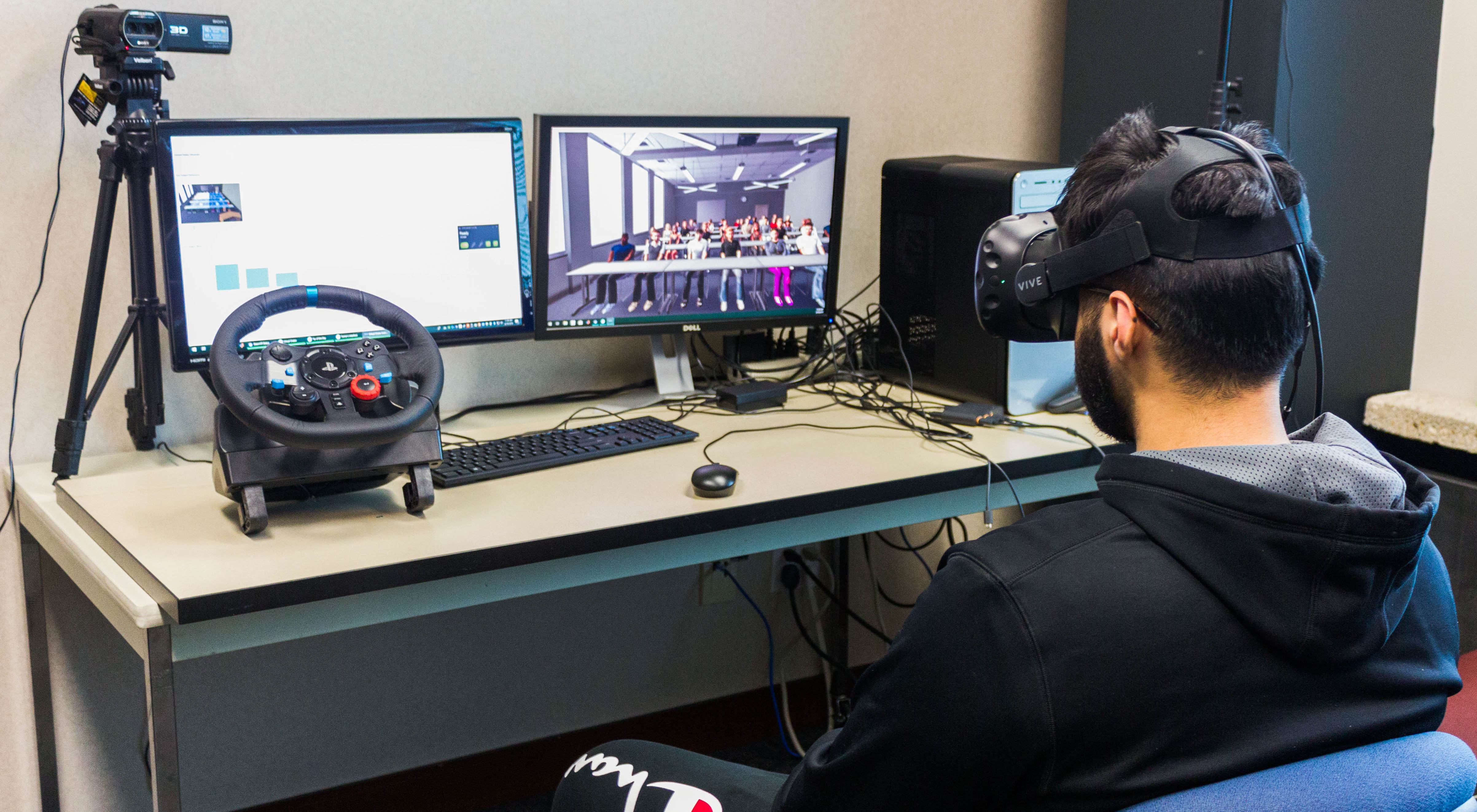
An ISTAR client practices for their final speech using the new VR stuttering programming.
It is well known in the speech-language pathology community that people who stutter can face a lot of anxiety when it comes to speaking situations.
But new research from the University of Alberta's Institute for Stuttering Treatment and Research (ISTAR) is trying to change that with a little help from virtual reality.
"Right now, we're using our VR technology to allow clients to practice for their final speeches-a written piece that intensive stuttering clinic participants present at the end of their treatment," explains Torrey Loucks, research chair in stuttering, ISTAR and associate professor, Department of Communication Sciences and Disorders, Faculty of Rehabilitation Medicine, University of Alberta. "Clients conduct their speeches in a virtual world that mimics an actual public speaking situation-on a stage, at the front of a room, at a boardroom table. What we want is to provide challenging communication situations so that people who stutter can practice their skills they use in therapy and also reduce the anxiety they feel going into a social situation."
In recent years, research has shown that the communication anxiety that people who stutter face is very similar to what would be defined as social anxiety disorder. In fact, for almost 50 per cent of people who stutter, their fears around public speaking and social situations are severe enough to pass a screening test for social anxiety disorder.
However, while people who stutter may not experience the full spectrum of social anxiety disorder characteristics, they often share some of the diagnostic features.
"We can have people who are largely fluent-they've made excellent gains in treatment, they maintain those gains-but communicating in public can still give them tremendous anxiety," says Loucks. "The social anxiety is definitely secondary to the stuttering, though-if the person didn't stutter they probably wouldn't have a fear of public speaking or being in social situations."
Those who showcase social anxiety disorder characteristics along with stuttering may require more in-depth therapy when it comes to being comfortable during social interactions.
This is where virtual reality comes in.
"These kinds of virtual reality tools provide social situations in which people can go through some type of communicative exercise, whether it be a speech, socializing or just being with people," says Loucks.
A customized experience for each individual
"The virtual reality technology and programming currently available at ISTAR allows therapists to choose environments that fit with their clients' needs. For instance, if a client is just starting out, they can be placed in a virtual room with no avatars present so that they are able to get comfortable. After that, the number of avatars can be adjusted as therapy progresses. Receptiveness of the group of avatars can also be adjusted to see how stutterers react when faced with distractions such as talking, whispering and movement."
Essentially, therapists can create an exposure therapy regiment for virtual reality, where the environment becomes more challenging as time goes on and people are exposed to situations that they find anxiety-provoking.
"You can add environmental noise, change the lighting, move the position of the speaker (client) or make the setting casual or formal."
Every client receiving treatment at ISTAR who consents to participate in the virtual reality project is asked to fill out a questionnaires. This allows Loucks to monitor the rate of anxiety pre- and post-practice.
"We want to work off of the research that is already available and apply it to those who stutter," explained Loucks. "There has already been a little bit of research conducted using virtual reality with those who stutter, which has found that virtual reality environments elicit the same kinds of disfluencies as speaking in everyday real-life environments. So we know that when we use this technology, clients are still facing the same kind of speech challenges as they normally would-this gives us hope that virtual reality will provide useful speech opportunities for ISTAR clients. We really want to continue to look at the benefits of this."
VR does not replace real-life scenarios
While the virtual world does not replace actual environments to perform in, the augmented practice allows therapists and their clients to use those real-life scenarios more strategically and make the experience more valuable.
"When we run intensive clinics, instead of having three sessions where volunteers come in and clients are required to give a speech each time, we can have them practice under VR and complete one speech in front of volunteers and make that speech more valuable-they can practice harder and more often under VR to really get the most out of their one public speech."
Although research is still ongoing, Loucks is very hopeful that the virtual reality stuttering program will greatly benefit therapists and their clients.
"The literature suggests that virtual reality exposure therapy or cognitive behavioural therapy delivered through virtual reality environments can benefit people with social anxiety disorder. Fear of public speaking and performance anxiety are sub-types of social anxiety disorder. Oftentimes, people who stutter fall into one or both of these sub-types."
"What we want is to provide challenging communication situations so that people who stutter can practice their skills they use in therapy and also reduce the anxiety they feel going into a social situation."